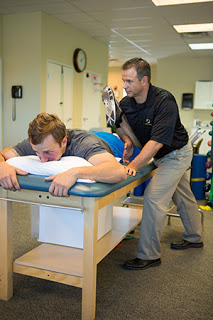Should Physical Therapy Hurt?
By Ryann Roberts, DPT , Cert DN
AZOPT Owner and Physical Therapist
Many people believe that physical therapy is painful. However, it should never be painful to the extent that you do not want to attend. Yes, there is pain involved in physical therapy. This is due in large part to the pain people already experience, or the reason they seek physical therapy. We aim to reduce that pain.
For example, you have symptoms of pain in your neck or low back. This pain is affecting your daily activities. Sleeping, dressing, and household chores are painful. It hurts to sit, stand, walk. Not to mention, you are now avoiding the activities you used to love. You NEED to address the cause of the pain. We seek to determine the root cause of your pain:
- Are the supporting muscles weak and/or tight?
- Are the muscles working correctly to support your joints?
- Are your supporting tissues in a constant state of contraction, thus working too hard?
- Are your joints able to move through their intended range of motion or are limitations in the tissue hindering mobility?
Following your initial assessment of pain, a physical therapist will prescribe a plan of care to address your specific concerns. This plan will include hands-on manual therapy techniques like stretching, tissue release, and soft tissue manipulation. The physical therapist will use their best tool – their hands – to reduce the local restrictions, tissue limitations, joint dysfunctions and local swelling to improve pain free mobility.
Keep in mind, the more the prolonged pain and limitations in your life, the tighter the tissue restriction. You can anticipate some soreness or ‘pain’ as a direct result of this tissue mobilization. It is necessary to achieve pain free mobility. However, this new ‘pain’ is different than the pain that brought you to physical therapy. This new ‘pain’ will subside in a day or two, ultimately helping the original pain decrease. This is true for any part of the body. In a total joint replacement, a physical therapist will push your range of motion to achieve a better overall outcome. At times, this may hurt, but again, should not cause increased pain beyond one or two days.
A physical therapist does not want to increase pain, even temporarily, but normal pain and soreness should be expected to achieve maximum results. Throughout each subsequent treatment session, residual pain and soreness will lessen and your initial symptoms will improve. If you feel your pain has increased, or is causing more limitations, it is best to attend your next session to discuss this with your physical therapist. Help is available, and can only be addressed when we know how you feel. The best time to seek advice from your physical therapist is when the pain is high.
If you are suffering from pain that is limiting your life, call AZOPT today to schedule your evaluation. Most insurance will allow an evaluation without a physician referral. Get your life back – call AZOPT today!







